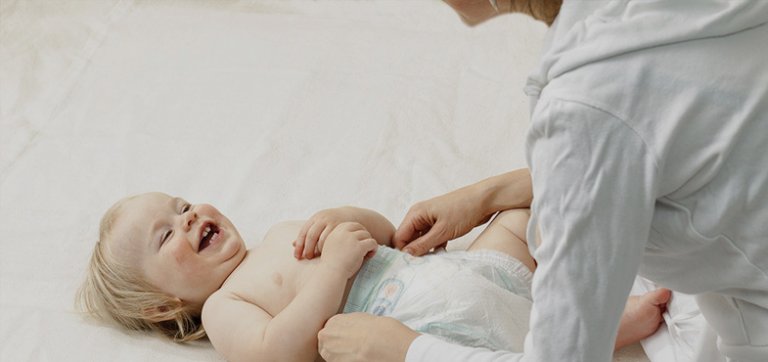The Art of Tickling and Kissing Your Baby's Belly


Written and verified by the psychologist Valeria Sabater
The wonderful art of tickling and kissing your baby’s belly produces wonderful side effects. You’re bound to get explosive laughter and positive emotions.
Few fathers and mothers can resist the delicious temptation to burry their faces in their baby’s tender tummy. They create a symphony of kisses and tickles that bring out their baby’s most contagious giggles (and their own, too).
This is more than just a classic parent-baby play activity. It’s a way to establish a strong emotional and social bond early on with our kids.
Today in “You Are Mom”, we want to talk to you about this healthy exercise. It’s a great sort of “therapy” that’s been practiced by generation after generation. Its benefits are so immense that you’ll probably keep it up for years to come.
Of course, there will always come the day when your child grows up and says he’s “too old for those kinds of things.”
Kissing your baby’s belly to raise him with more love and less anger
Bath times and diaper changes are perfect moments to carry out the magical art of kissing your baby’s belly.
This is something you can do from an early age, although you should always be careful. The best spots to kiss and tickle your baby are on his belly, chest, and the bottom of his feet.
The results, you will see, are marvelous.
Releases oxytocin
Oxytocin is a hormone linked to affection, care and tenderness. It plays a key role in the bond we create with the people we love. The more positive physical contact we share, the more oxytocin we release. And not only that, your baby will also receive a good dose of endorphins – the hormones associated with pleasure and well-being.
Tickles have a very concrete purpose: Creating social and emotional bonds

There’s something that we all know for sure: In order for tickling to make us laugh and to be enjoyable, it needs to come from someone we love.
- No stranger should ever tickle your child. This is something that your baby will learn very quickly. Only her parents and other close, trusted figures should be allowed to tickle them. These should be people that are part of her life who provide her with well-being, entertainment and comfort.
- Ticking establishes social and emotional bonds between people within the same environment. This should be a group of people with a caring and intimate relationship where positive emotions are shared.
Kisses and tickles strengthen the bond between you and your baby
Kisses and raspberries on your baby’s neck, belly and feet are a great way to connect with your baby. This is something so simple and so fun for both baby and parents.
Not only that, it helps to build a healthy bond with your baby. And of course, we all know by now that bonding is something all children need in order to grow and mature happily.
We can’t forget that positive physical contact based on skin-to-skin closeness is nourishment for your baby’s emotional health.
Those caresses and kisses that make your baby giggle are food for his soul. By caring for your little one’s emotional well-being, you’re laying a foundation for him to feel loved and respected.
When a baby is angry or in the middle of a temper tantrum, there is nothing better than a sudden symphony of kisses and raspberries

We’ve already talked to you here many times about babies that demand a lot of your attention – babies that always seem to want everything and are constantly protesting.
- Sometimes they refuse to put on their pajamas, and sometimes they go so far as to scream, hit or pull your hair.
- If your child is still very young, then you’ve certainly already realized how pointless it is to lecture and try to reason with him. So, when the going gets rough, pull out two fail-proof tools: Kisses and tickles.
- You’ll be surprised how your child’s mood changes almost instantly. The tension will disappear and you’ll be happy to see how he immediately starts to laugh.
Believe it or not, this is a way to show your child that he’s taken care of, and to help him control and manage his frustration. Later on he’ll reach a stage where you can sit down and reason with him. But during the first two years of life, this kind of emotional caress will be much more effective.
Respectful tickling is always more effective
Something that must be made clear is that tickling has a limit. If it bothers your child, you must stop immediately. Many of us carry unpleasant memories from our childhood of some family member pinning us down and tickling us. When tickling is unwelcome, it can seem like torture rather than a pleasant activity.

We need to be cautious and remember that in order for this to be an “art”, it should be fair, limited and balanced. It’s something that should be brief, or else the fun and the positive effect will turn into just the opposite.
Remember that respecting your child’s body and the limits that he or she imposes is a way to teach your little one to demand respect regarding his or her body in the future.
The wonderful art of tickling and kissing your baby’s belly produces wonderful side effects. You’re bound to get explosive laughter and positive emotions.
Few fathers and mothers can resist the delicious temptation to burry their faces in their baby’s tender tummy. They create a symphony of kisses and tickles that bring out their baby’s most contagious giggles (and their own, too).
This is more than just a classic parent-baby play activity. It’s a way to establish a strong emotional and social bond early on with our kids.
Today in “You Are Mom”, we want to talk to you about this healthy exercise. It’s a great sort of “therapy” that’s been practiced by generation after generation. Its benefits are so immense that you’ll probably keep it up for years to come.
Of course, there will always come the day when your child grows up and says he’s “too old for those kinds of things.”
Kissing your baby’s belly to raise him with more love and less anger
Bath times and diaper changes are perfect moments to carry out the magical art of kissing your baby’s belly.
This is something you can do from an early age, although you should always be careful. The best spots to kiss and tickle your baby are on his belly, chest, and the bottom of his feet.
The results, you will see, are marvelous.
Releases oxytocin
Oxytocin is a hormone linked to affection, care and tenderness. It plays a key role in the bond we create with the people we love. The more positive physical contact we share, the more oxytocin we release. And not only that, your baby will also receive a good dose of endorphins – the hormones associated with pleasure and well-being.
Tickles have a very concrete purpose: Creating social and emotional bonds

There’s something that we all know for sure: In order for tickling to make us laugh and to be enjoyable, it needs to come from someone we love.
- No stranger should ever tickle your child. This is something that your baby will learn very quickly. Only her parents and other close, trusted figures should be allowed to tickle them. These should be people that are part of her life who provide her with well-being, entertainment and comfort.
- Ticking establishes social and emotional bonds between people within the same environment. This should be a group of people with a caring and intimate relationship where positive emotions are shared.
Kisses and tickles strengthen the bond between you and your baby
Kisses and raspberries on your baby’s neck, belly and feet are a great way to connect with your baby. This is something so simple and so fun for both baby and parents.
Not only that, it helps to build a healthy bond with your baby. And of course, we all know by now that bonding is something all children need in order to grow and mature happily.
We can’t forget that positive physical contact based on skin-to-skin closeness is nourishment for your baby’s emotional health.
Those caresses and kisses that make your baby giggle are food for his soul. By caring for your little one’s emotional well-being, you’re laying a foundation for him to feel loved and respected.
When a baby is angry or in the middle of a temper tantrum, there is nothing better than a sudden symphony of kisses and raspberries

We’ve already talked to you here many times about babies that demand a lot of your attention – babies that always seem to want everything and are constantly protesting.
- Sometimes they refuse to put on their pajamas, and sometimes they go so far as to scream, hit or pull your hair.
- If your child is still very young, then you’ve certainly already realized how pointless it is to lecture and try to reason with him. So, when the going gets rough, pull out two fail-proof tools: Kisses and tickles.
- You’ll be surprised how your child’s mood changes almost instantly. The tension will disappear and you’ll be happy to see how he immediately starts to laugh.
Believe it or not, this is a way to show your child that he’s taken care of, and to help him control and manage his frustration. Later on he’ll reach a stage where you can sit down and reason with him. But during the first two years of life, this kind of emotional caress will be much more effective.
Respectful tickling is always more effective
Something that must be made clear is that tickling has a limit. If it bothers your child, you must stop immediately. Many of us carry unpleasant memories from our childhood of some family member pinning us down and tickling us. When tickling is unwelcome, it can seem like torture rather than a pleasant activity.

We need to be cautious and remember that in order for this to be an “art”, it should be fair, limited and balanced. It’s something that should be brief, or else the fun and the positive effect will turn into just the opposite.
Remember that respecting your child’s body and the limits that he or she imposes is a way to teach your little one to demand respect regarding his or her body in the future.
All cited sources were thoroughly reviewed by our team to ensure their quality, reliability, currency, and validity. The bibliography of this article was considered reliable and of academic or scientific accuracy.
- Bowlby, J. (1986). Vínculos afectivos: formación, desarrollo y pérdida. Madrid: Morata.
- Bowlby, J. (1995). Teoría del apego. Lebovici, Weil-HalpernF.
- Garrido-Rojas, L. (2006). Apego, emoción y regulación emocional. Implicaciones para la salud. Revista latinoamericana de psicología, 38(3), 493-507. https://www.redalyc.org/pdf/805/80538304.pdf
- Marrone, M., Diamond, N., Juri, L., & Bleichmar, H. (2001). La teoría del apego: un enfoque actual. Madrid: Psimática.
- Moneta, M. (2003). El Apego. Aspectos clínicos y psicobiológicos de la díada madre-hijo. Santiago: Cuatro Vientos.
This text is provided for informational purposes only and does not replace consultation with a professional. If in doubt, consult your specialist.








